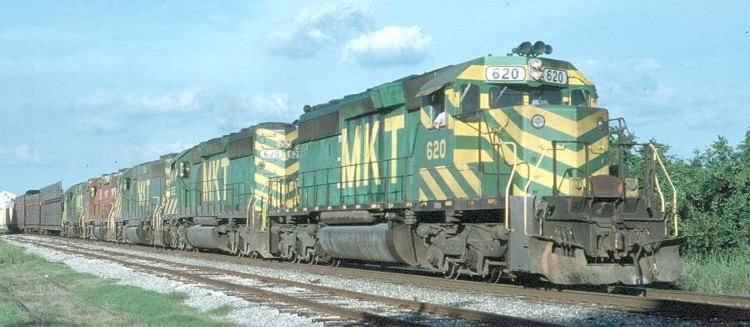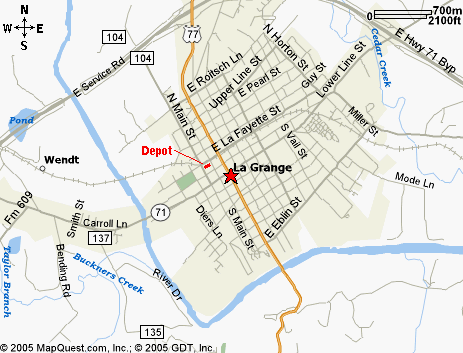Support this website by joining the Silver Rails TrainWeb Club for as little as $1 per month.
Click here for info.
This website has been archived from TrainWeb.org/mesquitebelt to TrainWeb.US/mesquitebelt.
La Grange, Texas

MKT 620, 625, and 3 other units lead a string of auto racks near La Grange May 15, 1988
Photo by Bill Phillips; copyrighted by
George Elwood's photo collection available at www.rr-fallenflags.org
La Grange the county seat of Fayette County, is on the Colorado River and State Highways 71 and 159, U.S. Highway 77, and the Missouri-Kansas-Texas Railroad in the central part of the county some sixty-three miles southeast of Austin. It is at the site where La Bahía Road crossed the Colorado River. Aylett C. Buckner settled in the vicinity about 1819, and in 1826 John Henry Moore built a twin blockhouse within what are now the city limits; he named it Moore's Fort. Area settlers sought shelter there from Indian attacks, and by 1831 a small community had developed around the fort.
The streets of La Grange were laid out several years before the organization of Fayette County in 1837. A town was platted in 1837, and when the Congress of the Republic of Texas established Fayette County that year, La Grange became its seat of government. The county had been named after the Marquis de Lafayette, and the county seat took its name from his chateau. A post office was established there in 1838, and that same year the Texas Congress passed a bill intended to place the capital of the Republic of Texas on a site contiguous with La Grange, but the bill was vetoed by Sam Houston.
First populated by Austin's colonists - "The Original Three Hundred", then followed by German immigrants in the 1840's and Czech and Moravians in the 1850's, La Grange grew as a trade center for the area's developing plantation economy. Its first newspaper, the La Grange Intelligencer, began to publish in 1844, and in 1846 the La Grange Female Institute was established. The first Methodist and Presbyterian congregations in La Grange were organized in the 1840s. La Grange was incorporated in 1850, and by 1855 it had at least four schools, including the La Grange Academy and the La Grange Male and Female Seminary and Boarding School.
The ethnic composition of La Grange began to change during the 1840s and 1850s, as increasing numbers of Germans and Czechs immigrated to Fayette County. The first Lutheran service in La Grange was conducted in 1851, and in 1859 the Casino Association of La Grange opened the area's first German Free School. In 1860 Heinrich Kreische, a German immigrant from Saxony, established in La Grange one of the state's first commercial breweries.
Though many of the German immigrants in the area were against slavery, the plantation economy of Fayette County influenced many La Grange residents to support southern rights as they understood them in the years leading up to the Civil War. In 1858, for example, a mass meeting was held in La Grange to protest the admission of Kansas to the Union as a free state. In early 1861, when the Civil War began, a number of militia companies were organized at La Grange to aid the Confederate cause. Some of the Germans in La Grange fled to Mexico or returned to Germany; still others formed the La Grange German Company, organized as a State Reserve unit in July 1861. Though La Grange was untouched by fighting during the Civil War, during Reconstruction the town was torn by conflict and disorder. Local peace was disrupted in May 1865 as returning Confederate veterans robbed local German businesses, provoked arguments and fights, and, on one occasion, threatened to burn down the town. La Grange was occupied by federal troops in 1866, and an agency of the Freedmen's Bureau was established there to protect the rights and welfare of the many freed slaves in the surrounding area. Friction between the federal authorities and ex-Confederates in the town led to a number of altercations that sometimes, as one source put it, "reached the proportions of a first-class riot ."
From August to December 1867 La Grange was ravaged by a deadly yellow fever epidemic that killed 240 people-about 20 percent of its population at the time. Some of the dead were buried in mass graves.
La Grange began to grow again as a trade center during the late 1800s, especially after the Galveston, Harrisburg and San Antonio Railway began service there in 1880 and the city's first bridge was built across the Colorado River in 1883. Though the arrival of the railroad helped to put the Kreische Brewery out of business, by 1884 the city included four churches, three schools, an opera house, an oil factory, and a bank. Its population had grown to 1,800, and two weekly newspapers, the Journal and the Slovan (a Bohemian paper), were being published. Two more banks were established in La Grange during the late 1880s, facilitating the local cotton trade and strengthening the city's position as a shipping center. A three-story stone county courthouse was completed in 1891. By 1896 the city had electric service and a waterworks, as well as the opera house, two bridges, four schools, five churches, three banks, three gristmills and cotton gins, and three newspapers, including the Deutsche Zeitung, a German-language publication. By 1900 some 2,392 people lived in La Grange.
The town declined during the first two decades of the 1900s; its population dropped to about 1,960 by 1910 and to about 1,665 by 1925. La Grange grew again during the late 1920s, however, to reach an estimated population of 2,800 in 1929. During the Great Depression the number of businesses reported in La Grange dropped from 130 in 1931 to only 75 in 1933; by that year the population had also declined to about 2,350. By 1939, however, La Grange had begun to recover, as that year 140 businesses and about 3,000 residents were reported there. After World War II the city's traditional economic base was threatened by declining cotton production in the area; during the 1950s La Grange civic leaders attempted to attract more industries. In 1960 the city included a mattress factory, a furniture-manufacturing plant, two banks, two cotton gins, three hatcheries, seven feed mills, and more than 100 retail establishments. By 1969 it also included a bottling plant, a structural-steel fabricator, and a business that built laminated beams; that year the city created a comprehensive plan for its future development. Nevertheless, by the early 1970s all but one of the cotton gins in La Grange had closed, and businesses in the city offered few new opportunities for young people; many left the city after graduating from high school. Meanwhile the population of La Grange varied from 2,729 in 1950, to 3,623 in 1960, 3,092 in 1970, and 3,768 in 1980.
La Grange received national attention during the late 1970s and early 1980s when the story of the Chicken Ranch was publicized through the Broadway production of "The Best Little Whorehouse in Texas" and by a Hollywood film of the same name. In 1990 the United States census counted 3,951 people living in La Grange. Just outside of the city is Monument Hill, where Nicholas Mosby Dawson and other members of the ill-fated Dawson massacre of 1842 are interred.
Information from The Handbook of Texas Online; a joint project of The General Libraries at the University of Texas at Austin and the Texas State Historical Association. The Handbook of Texas Online

Map courtesy of Mapquest
Return to the Home Page
History of the towns on the Mesquite Belt
Support this website by joining the Silver Rails TrainWeb Club for as little as $1 per month.
Click here for info.














